SAN DIEGANS FEEL RUSHED, MISLED BY SDPD AS ADVISORY BOARD VOTES NO ON SURVEILLANCE PROPOSAL
June 23, 2023 by JOE ORELLANA
LCRW is 100% reader-funded!
Support LCRW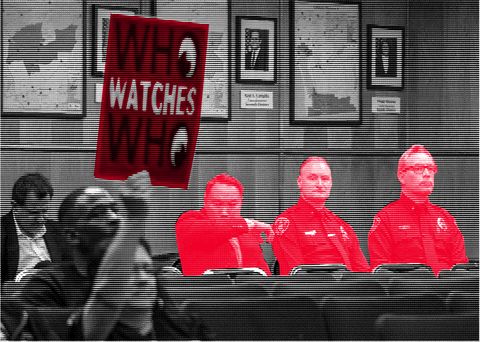
San Diego’s Privacy Advisory Board voted against recommending San Diego Police Department’s surveillance infrastructure proposal to City Council Thursday night. SDPD recently presented the project to the public at a series of events in early March. SDPD is seeking $4 million for the installation of five-hundred smart streetlights equipped with cameras and license plate readers. At a community summit, residents warned that the city had approved surveillance infrastructure in the past—without community input.
LCRW attended two of these educational meetings, and SDPD’s initial presentation to the Privacy Advisory Board. Residents worried that SDPD was rushing this proposal through without community input. At the community summit, attendees urged San Diego to oppose the invasive technology.

SDPD held presentations from March 6th through 10th. The proposed infrastructure includes an array of five-hundred cameras with license plate readers throughout the city. The sterile white boxes would be mounted on streetlight poles and do not resemble cameras to the layperson. SDPD characterizes the cameras as potentially the first deployment of several, building a surveillance network under their authority—SDPD would not need a judge’s approval to access the cameras.
BACKGROUND
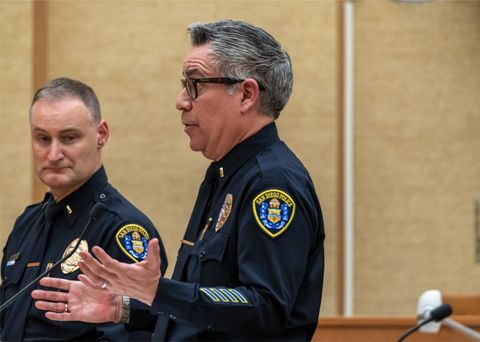
SDPD has sought surveillance technology before. It deployed ShotSpotter sensors seven years ago. The audio gunshot detection technology has been adopted in several cities. The firm behind it claims its sensors can identify gunshots and locate their origin, but is facing scrutiny over its reliability.
In San Diego, the technology was first deployed in four neighborhoods in the Southeast. in 2016. SDPD and the city cited rising gun-violence as justification. In that same year, San Diego’s Environmental Services deployed 3,200 cameras to be retrofitted onto streetlights. Potential powers for law enforcement agencies were included in the initial documentation, but this did not become a point of contention for years. Activists say SDPD monopolized the use of these cameras, and the promised climate and city planning benefits never materialized.
A 2020 investigation found that many of ShotSpotter’s alerts in San Diego were false positives. In 2021, the city abstained from renewing its contract with the firm. Mayor Gloria has said he intends to bring it back before the city council.
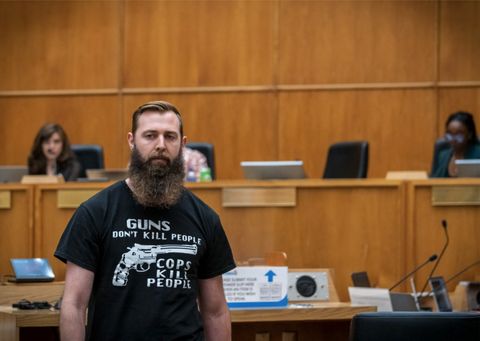
Also in 2020, public outcry led the city to limit police access to the last iteration of smart streetlights. Attempts to shut down the program were hampered by the firm providing the tech.
In that same year, city council unanimously approved the The Transparent and Responsible Use of Surveillance Technology ordinance. It created the Privacy Advisory Board, a body that reviews technology which may surveil San Diegans before city council votes on it. In 2022, SDPD fought for and won a carve out for officers working on federal task forces. In 2023, the PAB met for the first time. SDPD had to make its case for the surveillance technology before the board in April.
RESIDENTS REACT
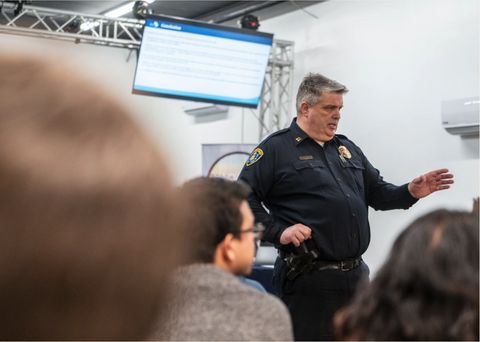
SDPD’s educational outreach meetings commenced on March 6th and went through the 10th. The presentation materials are online. LCRW attended two of these events.
The meetings were headed by Jeffery Jordon, a Captain with SDPD who works on policy and legislation matters for the department. He characterized himself as someone who is interested in data, and the ongoing developments in police policy. His presentations were followed by Q&A sessions.
Jordon argued that its utility outweighs its impact on the general public’s privacy. He outlined specific violent cases where the last round of surveillance infrastructure aided prosecutors.
SDPD plans to place cameras near an Islamic Center, a Planned Parenthood, and several businesses in Hillcrest, the heart of San Diego’s queer community.
The aforementioned Planned Parenthood is the site of regular clinic defense. On Saturdays, defenders gather to shield patients from anti-choice protesters.At the March 7th meeting, Jordon shared that SDPD is aware of community concerns over the state of reproductive rights. In order to comply with the Freedom of Access to Clinic Entrances Act, Jordon stated that locations offering reproductive care would be censored through software.
Clinic defenders have shared that protesters regularly peer over the fences at Planned Parenthood, and have found it difficult to get officers to intervene. These defenders have questioned whether anti-choice protesters are violating the FACE act, and whether SDPD is failing to enforce it.
One attendee asked if SDPD was translating for people who don’t speak English or the deaf and hard of hearing. Jordon indicated that the availability of the materials online facilitates translation by the end-user. He noted that this interpretation of accessibility had been cleared by “legal.” At the March 9th outreach, SDPD placed signs in English and Spanish that directed users to the slides online.
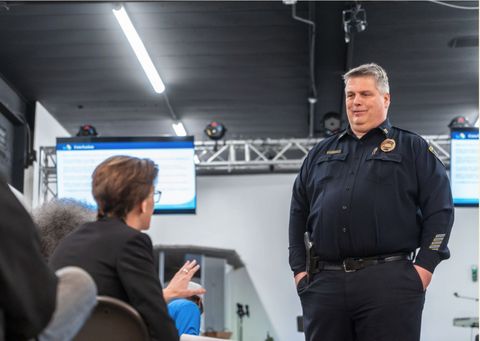
Some audience members were left wanting by Jordon’s answers. In one instance, questions about data retention and storage were abandoned when an audience member repeatedly misunderstood the presentation.
SDPD maintains that facial recognition and live monitoring are not parts of its current proposal. Additional capabilities would require the department to come before the PAB again. Jordon reiterated this point at both meetings LCRW attended. Several commenters argued that additional software is all that would be necessary to implement facial recognition.
Several attendees questioned whether the meetings were meant to dictate what SDPD was going to do regardless of community feedback. Others questioned why this particular proposal was the first to go before the PAB.
LCRW has obtained video of the March 8th meeting. In it, Jordon discussed the Oakland Police Department’s departure from the Joint Terrorism Task Force. He and a commenter dispute the necessity of San Diego’s carve-out for federal cooperation and the reason behind OPD’s departure from the JTTF.
“Oakland had a similar ordinance passed, and their officers continued to participate in task forces. So ours, in theory, could have continued to participate in task forces,” said the commenter.
“There are no Oakland officers on the Joint Terrorism Task Force any longer. Not after the ordinance,” Jordon replied.
Documents obtained by LCRW show that OPD continues to work with several federal task forces while complying with Oakland’s privacy regulations, but not the JTTF. Oakland’s city council voted to withdraw OPD’s officers from the JTTF in 2020 due to “the JTTF’s problematic history of repeatedly violating human rights across the country.” Oakland’s Privacy Advisory Commission was founded in two years prior.
At the end of the video, Jordon points to the camera-person and claims they’re filming for the commenter. The camera-person who provided the footage to LCRW disputes this claim.Notably, Jordon singled out a Voice of San Diego article on SDPD’s proposal at both the March 8th and 9th meetings. He was adamant that the article was inaccurate.
GOING BEFORE THE PRIVACY ADVISORY BOARD
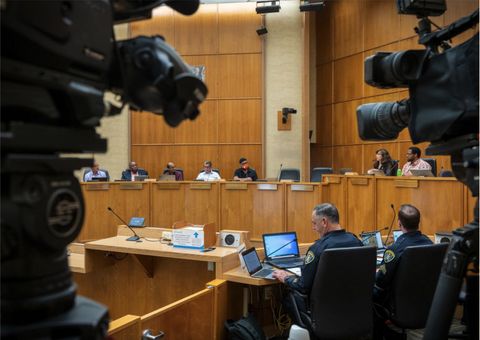
At its first meeting on March 15th, board member Paul Alexander inquired as to Kelso’s relation to an officer with the same surname. She is married to one Benjamin Kelso, a Captain in the SDPD. Board member Kelso characterized this question as dirty, and inappropriate for the work the board is doing. Some attendees bristled at the revelation.
On April 27th, the PAB convened to hear a number of items, including SDPD’s surveillance infrastructure proposal. SDPD’s presentation was helmed by their public information officer, Lieutenant Adam Sharki. He condensed the material from the community outreach events into a span of roughly twenty minutes. Sharki cited the case of Tyre Nichols as an example of the good this technology can do. Nichols was killed by Memphis police in January. The officers are now facing trial because streetlight camera footage contradicted their testimony. Sharki also cited the prosecution of a deputy who shot and killed a detainee—the shooting was captured on the last iteration of streetlight cameras. A commenter responded to this, questioning why SDPD’s response to bad officers is more surveillance and not greater discipline over its ranks.
Sharki presented the same usage metrics as Jordon did, with four-hundred uses of the cameras, two-hundred being useful to the investigation, and one-hundred of those being critical to the investigation according to the department.
Between 29,000 and 33,000 crimes were reported per year over the period SDPD examined. Per those figures,existing cameras were used to investigate roughly 0.67% of crimes. In SDPD’s presentation, looting and civil unrest investigations are categorized together. At 35 cases, they constitute 8.75% of investigations here.
A VOSD investigation found that SDPD investigated protesters during the 2020 uprising using the smart streetlight cameras 35 times.
NEXT STEPS
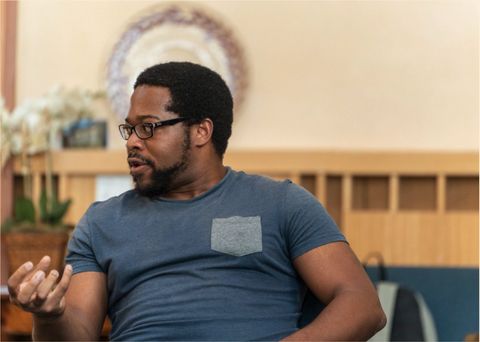
Community members from the TRUST Coalition and Activist San Diego held a summit about SDPD’s proposal on May 15th. PAB board chair Ike Anyanetu attended.
Anyanetu explained that the PAB decisions are not binding. While there’s pressure from city entities to move projects through, any proposal that surveils residents has to be approved, denied or modified by the board. He also pointed out issues the community had noticed with SDPD’s proposal—that these cameras likely would not be the last, and that invasive capabilities can be added with software updates.
Lilly Irani, a professor and member of the TRUST Coalition, noted that San Diegans still have to organize. She explained that the PAB gives people the time and means to organize and ask the city hard questions, but it’s incumbent on residents to organize.
Seth Hall, a technologist and activist, agreed with Irani. He said that after the PAB issues a recommendation, it’s out of the process, and then residents have to engage with city council. He noted that companies like Shot Spotter are organizing aggressively, meeting with neighborhood associations and delivering multimedia presentations.
“That’s our competition and we have to counter that model. We need your connections, your backyards. Get in touch. We will back you,” said Hall.
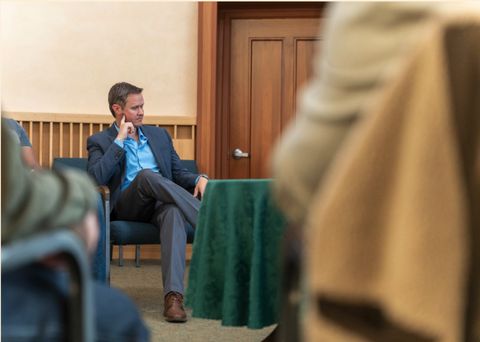
Colleen Cusack, an attorney who represents unhoused San Diegans pro-bono, drew parallels between the oppression faced by her clients and what SDPD intends to do. She compared the proposal to the 4th amendment violations suffered by her clients.
“It’s almost as If police are using homeless people like nursing students use pin cushions to test placing IVs,” said Cusack.
At this summit and the April 27th PAB meeting, Ike indicated that there’s more work to be done. The PAB has two months to review the proposal, and its members have signaled that they will seek more civilian input.
While the recommendations of the PAB are non-binding, it has to finish its review process before the surveillance infrastructure goes before city council. The city council will then vote on the technology, the funding, and the proposed use policy. Despite this, mayor Gloria’s proposed budget carves out $4 million for the surveillance infrastructure. His budget also substantially reduces funding for libraries.
After SDPD’s presentation to the board, Anyanetu spoke to residents’ concerns.
“I think that a lot of people who are against the technology would come and listen to what you say and would probably be convinced that this actually makes a lot of sense, he said. “If all these cities are doing it, and all there’s this public engagement and research, perhaps there’s something to it.”
“But I think, as it stands, we don’t know enough. And it’s just opening Pandora’s box,” he concluded.
the vote
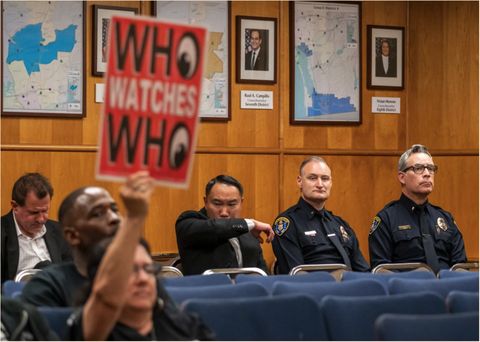
On June 22nd, the board voted to recommend that City Council reject SDPD’s proposal.
Board member Alexander asked Lara how SDPD could reassure the community that this technology would not perpetuate bias. Lara invoked officers’ constitutional oaths and the potential individual consequences for biased policing. Alexander characterized this response as SDPD simply asking to be trusted.
The board voted unanimously to recommend against adopting SDPD’s proposal. The police department will bring its proposal before the City Council as early as July.

